|
|
|
|
FüsS60 Bayonet from the from the
1st Naval Technical Depot Division
Photo ©
Roy Williams
|
 |
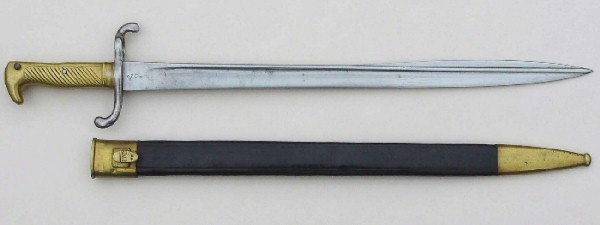 |
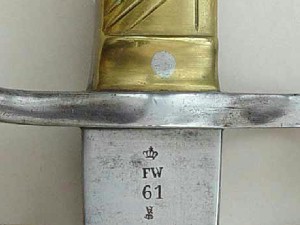 |
| |
|
| |
The markings "
I.W.D.225." show this Füsilier-Seitengewehr 1860 bayonet to have been issued to the
1st Technical Depot Division ("I. Werft Division")
based at Kiel,
weapon number 225. It has manufacturers markings for V Jung of Suhl. It is date marked "FW61"
under a Prussian crown on the blade for
King Frederick William IV 1861. The curious point here is that
Frederick William IV died on 2nd January 1861, so it seems
likely that bayonets were still being marked with his
monogram posthumously. The bayonet has brass grips and a leather
scabbard with brass mountings as was standard for the Füsilier-Seitengewehr
60. The scabbard is marked "I.W.D.167" on the frogstud.
The owner of this bayonet, Roy Williams,
is the author of
The Collectors Book of German Bayonets |
|
|
|
|
FüsS60 Bayonet from the
1st Naval Technical Depot Division
Photo ©
Roy Williams |
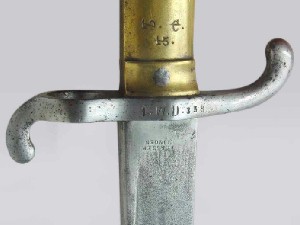 |
| |
The markings "1.W.D.358" show this
bayonet to have been issued to the Imperial Navy, 1st Technical Depot
Division ("I. Werft Division") based at Kiel,
weapon number 358. It has manufacturers markings for
F Hörster of Solingen.
The bayonet also has previous cancelled markings on the brass
handle "10.C.15" which have not been fully identified but may
refer to the 10th company of a Prussian Fusilier regiment. The
bayonet has brass grips and a leather
scabbard with brass mountings as was standard for the Füsilier-Seitengewehr
60. The scabbard is marked "I.W.D.48" on the frogstud.
|
|
|
|
|
|
Hf71 Bayonet from the Imperial Navy
Photos ©
Roy Williams |
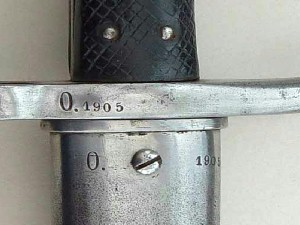 |
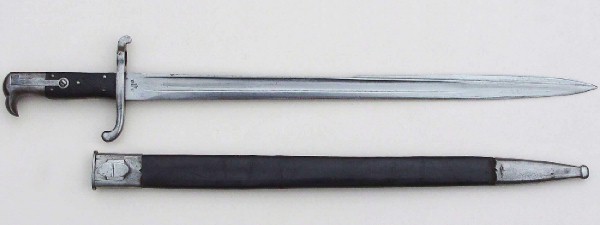 |
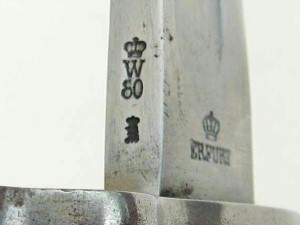 |
| |
|
| |
The markings "O.1905"
on the hilt and scabbard show this
Hirschfänger 71 bayonet to have been issued at the Baltic Sea
Naval Command Station ("Marinestation der Ostsee")
in
Kiel, weapon number 1905. It has manufacturers markings for both
Erfurt and Simson Bros ("Gebr. Simson")
of Suhl and is date marked "W80" for Kaiser Wilhelm I, 1880. It has leather grips and a leather
scabbard with steel mountings as was standard for the Hirschfänger 71.
|
|
|
|
|
Hf71 Bayonet from 1st Sailors Depot
Division
Photo ©
Roy Williams |
 |
| |
The markings "I.M.D.4495" show this
bayonet to have been issued to the 1st Sailors Division ("I.
Matrosen Division") of the Imperial Navy,
weapon number 4495.
It has previous (yet uncancelled)
"O.4030" markings showing this
bayonet originally to have been issued at the Baltic Sea Naval Command
Station ("Marinestation der Ostsee"),
weapon number 4030. The scabbard has the markings "II.M.D.1781"
for the 2nd Sailors Division ("II. Matrosen Division") of
the Imperial Navy,
weapon number 4495. It has
manufacturers markings for both Erfurt and Simson Bros ("Gebr.
Simson") of Suhl and is date
marked "W82" for Kaiser Wilhelm I, 1882. It has leather grips and a leather
scabbard with steel mountings as was standard for the Hirschfänger 71.
|
|
|
|
|
|
|
Hf71 Bayonet from the Imperial
Navy Photos
© Shawn Gibson of
Bayonet
Connection |
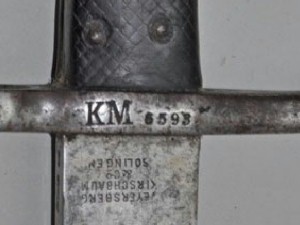 |
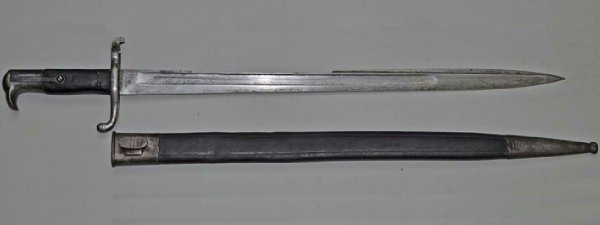 |
The markings "KM
6593" show this
bayonet to have been issued to the Imperial Navy ("Kaiserliche Marine"),
weapon number 6593. It has manufacturers markings for Weyersberg,
Kirschbaum & Co in Solingen on one side and Erfurt on the other.
Several bayonets have been seen with two makers marks like this. It
may be that the blade was made by one factory and the bayonet hilted
and assembled by another. It is dated marked "W86" for
Kaiser Wilhelm I, 1886. It has leather grips and a leather
scabbard as was standard for the Hirschfänger 71.
|
|
Hf71 Bayonet from 1st Sailors
Depot Division Photos
© Shawn Gibson of
Bayonet
Connection |
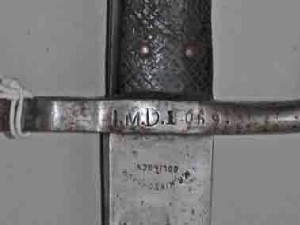 |
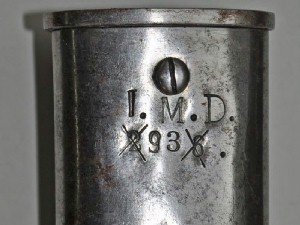 |
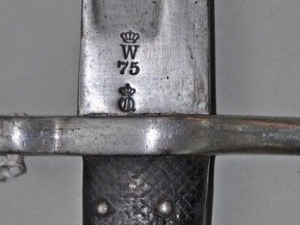 |
| The
markings "I. M.D. 1069" show this
bayonet to have been issued to the 1st Sailors Depot Division ("I. Matrosen
Division") based at Kiel,
weapon number 1727. The scabbard is again marked "I.M.D." but with a
different weapon number (2936, curiously with the 2 and 6 cancelled
out) showing that it was at one time issued with another bayonet. It
is date marked on the flat of the blade, W75 for Kaiser Wilhelm I,
1875. It again has standard leather grips.
Privately Made S71 Bayonet from the Imperial Navy
Photo ©
Roy Williams |
|
|
|
This bayonet has no unit, date or
manufacturer's markings. Like many
officers and NCOs edged weapons it is privately made for dress
purposes. It has a flat
blade with a decorative engraving showing
a
crossed trident and oar, an inlaid gold fouled anchor under a crown
(see left) and a three masted sailing ship (see right). It has brass
grips and a leather scabbard as was standard on the S71. It may have
been made for a naval cadet.
S71/84
Bayonet from the 1st Sailors Depot Division Photo ©
Chris Wood |
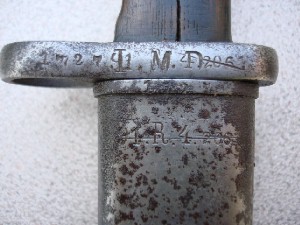 |
 |
| The
markings "1727. I. M.D" show this
bayonet to have been issued to the 1st Sailors Depot Division ("I. Matrosen
Division"),
weapon number 1727.
Curiously in this case the weapon number is marked before the
unit. It also has previous cancelled markings on the hilt and scabbard reading
"91.R.4.206" for the 91st Oldenburg Infantry Regt ("Oldenburgisches
Infanterie-Regiment Nr.91"),
4th company, weapon number 206. The naval base at Wilhelmshaven
was in a Prussian enclave on the Oldenburg coastline.
Interestingly two other bayonets have been noted with "I. MD"
markings over cancelled army markings. In all three cases the army
markings are from regiments garrisoned on the coast (the other two
examples being from the 84th Schleswig Infantry Regt ("Infanterie-Regiment
von Manstein (1.Schleswigsches) Nr.84") and the 85th Holstein
Infantry Regt ("Infanterie-Regiment
Herzog von Holstein (1.Holsteinisches) Nr.85"), the third
battalion of whom were based at Kiel). It would therefore appear
that local army units sent these bayonets directly to the navy
rather than to a central store for re-distribution. It was made by
Weyerberg, Kirschbaum & Cie in Solingen in 1887 (date marked "W87").
S98aA Bayonet from the 2nd Naval Technical Depot Division Photo ©
Chris Wood |
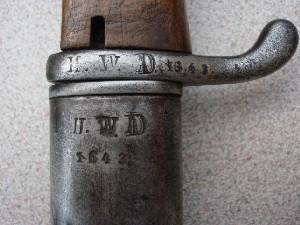 |
 |
| The
markings "II. W.D. 1643" on the hilt and scabbard show this bayonet to have been issued to the
2nd Technical Depot Division ("II. Werft Division"),
based at Wilhelmshaven, weapon number 1643 (although the "1" appears to
have been cancelled out, in which case it may be weapon number 643). This bayonet also has the
cancelled markings "II T.A." possibly the II. Torpedo Abteilung
from a previous issue. Several bayonets may have made the same
journey from Torpedo units to the Werft Division and another
similar S98aA has also been recorded with "II. W.D." markings over
cancelled "T.A." markings. This bayonet was made by Simson & Co of Suhl and does
not have a date mark.
|
|
|
|
S98nA Bayonet from the 2nd Sailors Depot Division
Photo © Chris Wood |
 |
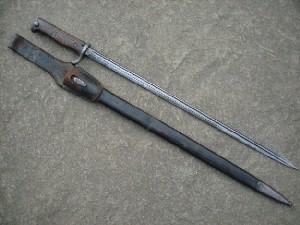 |
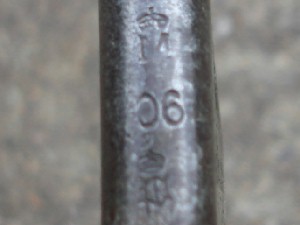 |
The
markings "II M D 8358" on the hilt and scabbard show this bayonet to have been issued to the
2nd Sailors Depot Division ("II. Matrosen
Division"), based at Wilhelmshaven, weapon number 8358. It was made by Simson & Co
of Suhl and and is dated marked with an imperial crown over the letter
"M" over the number 06 for 1906 (see photograph on the
right).
Note that "MD" is also stamped into the back of the frog.
Shortened S98nA Bayonet from the 2nd Sailors Depot Division Photo ©
Chris Wood |
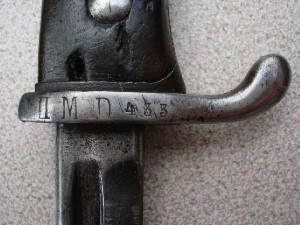 |
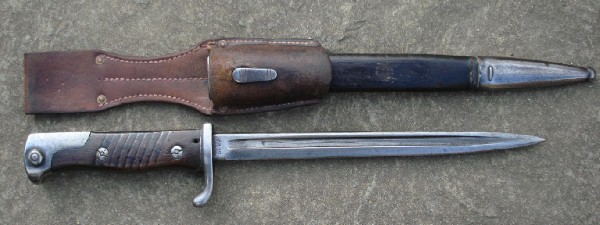 |
The
markings "II M D 433" show this
bayonet to have been issued to the 2nd Sailors Depot Division ("II. Matrosen
Division") of the Imperial Navy,
weapon number 433. It was made by Simson &
Co of Suhl and and is date marked with an imperial crown over the
letter "M" over the number 06 for 1906. This is a shortened
bayonet with the scabbard shortened to match. Period photographs
further
confirm the use of shortened S98 bayonets by the imperial navy.
| S84/98aA
Bayonet from the 2nd Sailors Depot Division Photo ©
Chris Wood |
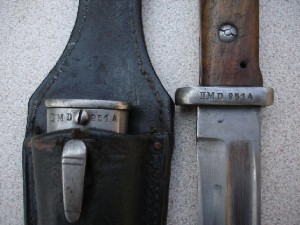 |
%20t.jpg) |
| The
markings "II. MD 8514" on the hilt and scabbard show this
bayonet to have been issued to the 2nd Sailors Division ("II. Matrosen
Division") of the Imperial Navy,
weapon number 8514. The S84/98 bayonet was a modification of the
S71/84 short bayonet for use on the G98 rifle and carbine. This
blade is marked as being made by Weyerberg Kirschbaum & Cie in
Solingen in 1887 (date marked "W87"). It would have been
modified into the S84/98 variant at a later date. Note
the crowned "M" for "Marine" or navy stamped into the leather
bayonet frog. |
| |
|
S98/05aA
Bayonet from the Imperial Navy Photos
© Chris Wood |
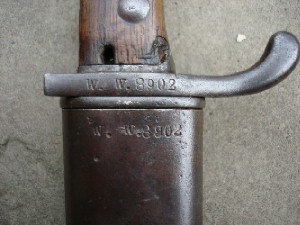 |
 |
|
This bayonet hilt and steel mounting on
the leather scabbard have the markings "W.W.8902",
for "Werft Wilhelmshaven" showing it have been issued to
sailors equipped at the port of Wilhelmshaven, weapon number 8902. It
was made at Erfurt in 1909 (date marked "W09").
S98/05aA
Bayonet from the Imperial Navy Photos
© Chris Wood |
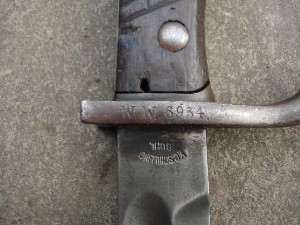 |
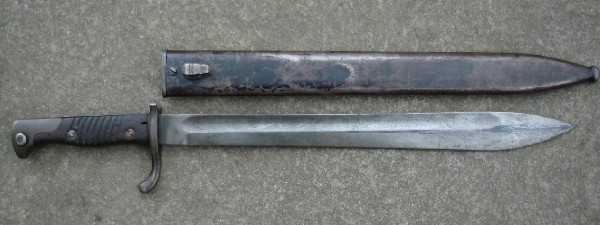 |
|
This bayonet
has the markings "W.W.6934.", for "Werft
Wilhelmshaven" showing it have been issued to sailors equipped at
the port of Wilhelmshaven, weapon number 6934. It was made by VC
Schilling of Suhl in 1912 (date marked "W12"). This bayonet is a curious
transitional version of the S98/05 with the high muzzle ears of the
S98/05aA but the added flashguard of the S98/05nA. Flashguards were sometimes added to
S98/05aA bayonets (possibly
by unit armourers) if they were issued K98az carbines as they then
needed protection from the muzzle flash.
Three S98/05aA Bayonets from the
Imperial Navy
Photo ©
Roy Williams

These bayonets have the markings "W.W." for "Werft
Wilhelmshaven" showing them to have been issued to sailors equipped at
the port of Wilhelmshaven. The weapon numbers run consecutively from
left to right, 6441, 6442 and 6443. They were made by VC
Schilling of Suhl in 1912 (date marked "W12"). Number 6441
has a flashguard, the others do not.
S98/05aAS Bayonet from the SMS Goeben Photos ©
Chris Wood |
 |
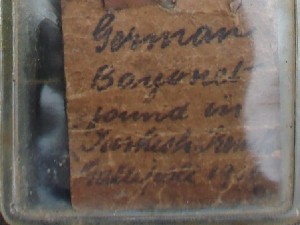 |
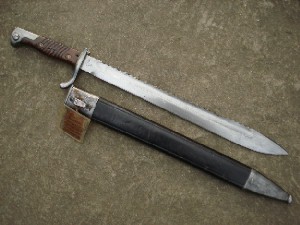 |
| This bayonet
has the markings "W.K.2500", for "Werft Kiel" showing it have
been issued to sailors equipped at the port of Kiel, weapon number
2500. It was
made at Erfurt in 1908 (date marked "W08"). It has wooden grips and a steel mounted leather scabbard.
This bayonet is of particular interest as it has a hand written note
attached stating that it was "found in Turkish trenches Gallipoli
1915". It is then almost certainly one owned by a sailor from either
the SMS Goeben or SMS Breslau, both of which supplied sailors to serve
in machine gun units on the Gallipoli front. As the SMS Goeben was
equipped at Kiel (whereas the SMS Breslau was equipped at
Wilhelmshaven) it is most likely that this bayonet is from a sailor
from the SMS Goeben. |
S98/05aAS
Bayonet from the 2nd Sailors Artillery Detachment Photo ©
Chris Wood |
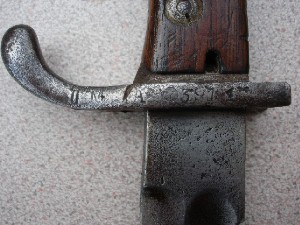 |
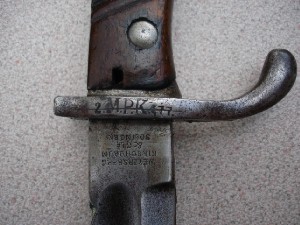 |
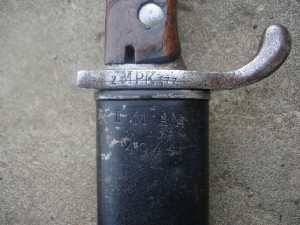 |
The markings
"II MAA 3911" only just visible in the left photograph show
this bayonet to have been issued to the 2nd Sailors Artillery Detachment
("2. Matrosen Artillerie Abteilung"),
weapon number 3911. This bayonet also has the
cancelled markings "2.M.P.K. 177" for the 2nd Naval Pioneer
Company ("2. Marine Pionier Kompagnie")
of the Marinekorps Flandern on the other side of the hilt seen in the
centre photo. Note that in the photograph on the right, the markings
on the blackened steel scabbard read "II MAA
4944". This is the same unit as the bayonet but a different weapon
number. Also
visible in the photograph in the centre is the manufacturer's marking
for Weyersberg, Kirschbaum & Co of Solingen.
The bayonet is date marked "W14" for 1914.
S98/05aAS
Bayonet from the 2nd Naval Pioneer Company Photo ©
Chris Wood |
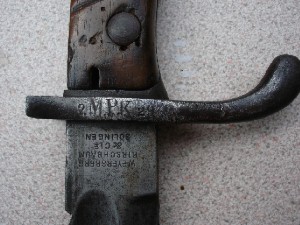 |
 |
The
markings "2. M.P.K. 29" show this
bayonet to have been issued to the 2nd Naval Pioneer Company ("2. Marine Pionier Kompagnie")
of the Marinekorps Flandern,
weapon number 29. The manufacturer's
marking for Weyersberg, Kirschbaum & Co
of Solingen can again be clearly seen on the blade. It is date marked
"W14" for 1914. S84/98nAS Bayonet
from the Imperial Navy Photo
© Dow Cross
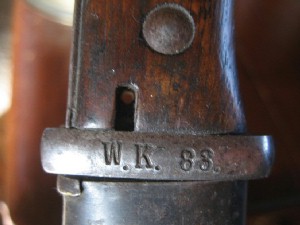 |
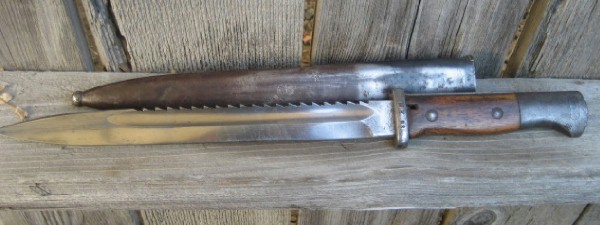 |
| This bayonet has the markings "W.K.88." for
"Werft Kiel" showing it have been
issued to sailors equipped at the port of Kiel, weapon number
88. These markings are unusual firstly because naval bayonets of
this period (1915-16) were not usually unit marked and also
because of the very low weapon number (see example WK2500 made
in 1908 above). It has wooden grips, a steel scabbard and a
sawback blade. |
|
|
Please
contact me here if you have more
information or photos on this topic.
Back to
Main Menu for German Colonial Uniforms
|